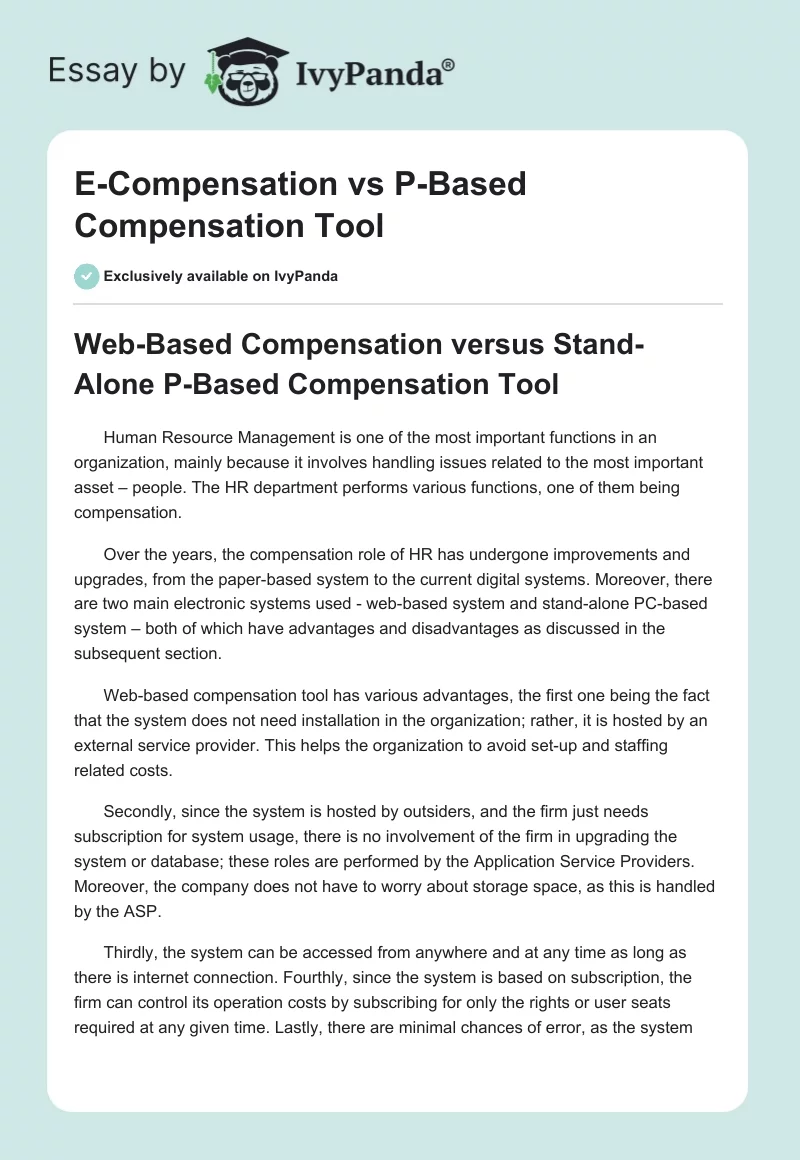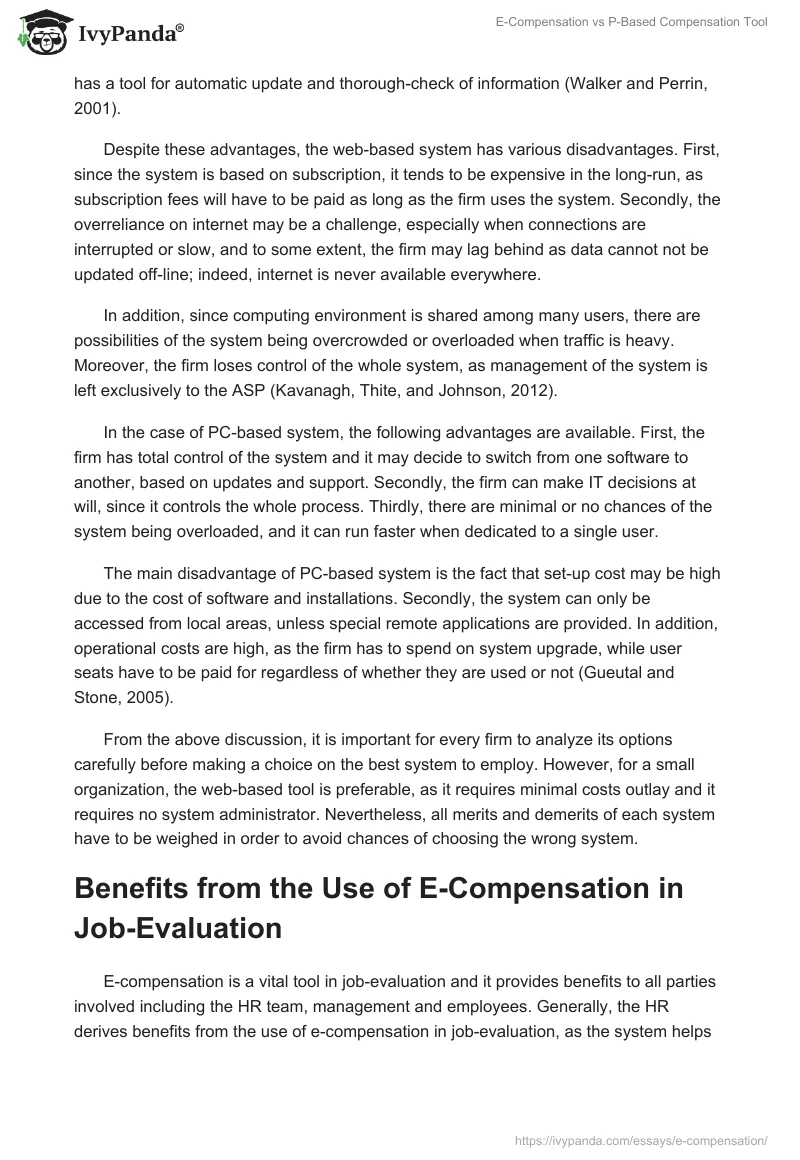- Web-Based Compensation versus Stand-Alone P-Based Compensation Tool
- Benefits from the Use of E-Compensation in Job-Evaluation
- Benefits and Drawbacks of Centralized Approach to Managing Merit Pay System
- Types of Integrated Analytical Features in Compensation Planning
- Obstacles to achieving Potential of Web-Based Internal Equity Tools
- Strategies Used By HR to Evaluate the Quality of Market Data
- References
Web-Based Compensation versus Stand-Alone P-Based Compensation Tool
Human Resource Management is one of the most important functions in an organization, mainly because it involves handling issues related to the most important asset – people. The HR department performs various functions, one of them being compensation.
Over the years, the compensation role of HR has undergone improvements and upgrades, from the paper-based system to the current digital systems. Moreover, there are two main electronic systems used – web-based system and stand-alone PC-based system – both of which have advantages and disadvantages as discussed in the subsequent section.
Web-based compensation tool has various advantages, the first one being the fact that the system does not need installation in the organization; rather, it is hosted by an external service provider. This helps the organization to avoid set-up and staffing related costs.
Secondly, since the system is hosted by outsiders, and the firm just needs subscription for system usage, there is no involvement of the firm in upgrading the system or database; these roles are performed by the Application Service Providers. Moreover, the company does not have to worry about storage space, as this is handled by the ASP.
Thirdly, the system can be accessed from anywhere and at any time as long as there is internet connection. Fourthly, since the system is based on subscription, the firm can control its operation costs by subscribing for only the rights or user seats required at any given time. Lastly, there are minimal chances of error, as the system has a tool for automatic update and thorough-check of information (Walker and Perrin, 2001).
Despite these advantages, the web-based system has various disadvantages. First, since the system is based on subscription, it tends to be expensive in the long-run, as subscription fees will have to be paid as long as the firm uses the system. Secondly, the overreliance on internet may be a challenge, especially when connections are interrupted or slow, and to some extent, the firm may lag behind as data cannot not be updated off-line; indeed, internet is never available everywhere.
In addition, since computing environment is shared among many users, there are possibilities of the system being overcrowded or overloaded when traffic is heavy. Moreover, the firm loses control of the whole system, as management of the system is left exclusively to the ASP (Kavanagh, Thite, and Johnson, 2012).
In the case of PC-based system, the following advantages are available. First, the firm has total control of the system and it may decide to switch from one software to another, based on updates and support. Secondly, the firm can make IT decisions at will, since it controls the whole process. Thirdly, there are minimal or no chances of the system being overloaded, and it can run faster when dedicated to a single user.
The main disadvantage of PC-based system is the fact that set-up cost may be high due to the cost of software and installations. Secondly, the system can only be accessed from local areas, unless special remote applications are provided. In addition, operational costs are high, as the firm has to spend on system upgrade, while user seats have to be paid for regardless of whether they are used or not (Gueutal and Stone, 2005).
From the above discussion, it is important for every firm to analyze its options carefully before making a choice on the best system to employ. However, for a small organization, the web-based tool is preferable, as it requires minimal costs outlay and it requires no system administrator. Nevertheless, all merits and demerits of each system have to be weighed in order to avoid chances of choosing the wrong system.
Benefits from the Use of E-Compensation in Job-Evaluation
E-compensation is a vital tool in job-evaluation and it provides benefits to all parties involved including the HR team, management and employees. Generally, the HR derives benefits from the use of e-compensation in job-evaluation, as the system helps the HR to differentiate various jobs based on their descriptions and relationship (Gueutal and Stone, 2005).
In addition, the HR is able to peg salaries and benefits on the jobs based on their ratings, thus ensuring uniformity in compensation. Moreover, with e-compensation, it is easier to compare data from the industry for related jobs and then make informed decisions on compensation package that is most suitable for the job. In addition, e-compensation helps both the HR and management to use automated base salary increments, which are automatically routed for approval during review periods.
Employees also benefit from the use of e-compensation in job-evaluation, as total compensation reporting is provided. In addition, e-compensation ensures equity in employee compensation, as human errors and biases are eliminated through automated and programmed job-evaluation process.
Moreover, information for making decisions affecting employees is available throughout, thus making job-evaluation easy; indeed, the system allows information to be accessed at any time as long as one is connected to the system, thus saving on time and cost (Gueutal and Stone, 2005).
Benefits and Drawbacks of Centralized Approach to Managing Merit Pay System
Merit pay system is a compensation system where employees are paid based on their performance. Basically, there are two main approaches used to manage this system – centralized approach and decentralized approach – both of which have benefits and drawbacks. Centralized approach allows the HR specialists, the discretion to control pay increments based on various factors such as budget constraint, turnover, market pressure and so on (Gueutal and Stone, 2005).
Secondly, it is easy to transfer employees from one department to another with a view of increasing performance. Thirdly, decision-making is easy and fast, as it does not involve many departments or personnel; rather, the HR uses merit increase grids as guidelines. One drawback of centralized approach is that, “the compensation program may suit general corporate needs, but not individual department’s needs” (Gasbarre, N.d).
Secondly, line managers are excluded from merit pay administration despite their direct interaction with the employees; as such, there is a possibility of incorrect data being used in compensation. Lastly, centralized approach has limitations in motivating employees, as HR managers do not have direct contact with employees in their workstations; as such, they may not provide other incentives except money to motivate them.
Types of Integrated Analytical Features in Compensation Planning
With the changing HR environment, managers need to embrace the use of technology that will enhance the whole compensation process to remain competitive. One type of integrated analytical feature of an e-compensation planning is presence of a compensation planner data sheet, which helps managers to make informed decisions as well as to enhance efficiency in compensation process.
This feature provides solutions based on available salary budget and allocation procedures, as well as historical reward data; in the process, it helps in minimizing costs and controlling budget. Therefore, this feature helps managers to make compensation based on performance index, and motivate employees without having to spend beyond their budget limit.
Another feature is enterprise resource planning feature that enables integration of various HR data, including employee’s profiles, job title/description, grade and salary range, and performance appraisal in order to be used effectively in compensation planning. This saves valuable time for the HR; it also helps the HR to avoid hassles of collating and transferring data for decision making. Moreover, this feature allows HR to create rules and to filter employee groups through an automatically updating support tool.
The third feature is the integrated manager self-service tool that enhances planning and allocation of various compensation components through enhanced decision making capability. Here, managers can easily update any aspect arising in the organization related to employee compensation including employee change in status, pay increment, bonus recommendation, and interdepartmental transfer among others.
Obstacles to achieving Potential of Web-Based Internal Equity Tools
Web-based internal equity tool is an important compensation tool used by organizations in the contemporary HR environment. Normally, it involves online job evaluation, pay grading and performance analysis to ensure employees are equitably compensated within the organization (Information Resources Management Association, 2011). However, there are various challenges that HR faces in the use of this tool, thus failing to gain from its potential benefits.
One of the barriers is the fact that most of the web-based internal equity tools “are not generally integrated across software packages” (Gueutal and Stone, 2005, p. 173). Software programs that support this tool may be available in the market, but their availability in the web may be a problem.
Secondly, many organizations still believe in external equity, thus they are not motivated to embrace internal equity; as a result, they fail to invest in web-based internal equity tools. Thirdly, the organizations may lack skilled employees on the use of web-based compensation tools, while at the same time the organization may fail to invest in this tool.
Strategies Used By HR to Evaluate the Quality of Market Data
The quality of market data used in HR decision is very important because any compromise in quality of data will definitely lead to improper decisions. It is also important that all data received by the HR must be accurate in order to avoid incurring unnecessary costs due to inaccurate compensation.
Generally, HR’s initial role is to review data received from the market to establish its credibility, completeness, and reasonableness. One of the strategies used by HR to evaluate the data is the use of Data Quality Matrix (DQM). Here, data from different sources is classified into a “set of standard, simple, useful categories of quality” (Hanson, N.d). This strategy uses data calibration records, accuracy checks, duplicate samples and split sample to assign data to quality levels, which may be bias or precision.
Another strategy for evaluation of the quality of data is the use of data quality scorecard. This strategy “allows aggregated analysis and drill-downs” (Maydanchik, 2007, p.294), and provides scores to data, based on its quality rating.
The other data evaluation strategy is the recurrent data quality assessment, which involves initiation of data quality improvement program to determine the credibility of data collection process. This strategy normally focuses on assessment of data trend by setting benchmarks and identifying any potential sources of data quality compromise.
References
Gasbarre, D. (N.d). Compensation Administration. Encyclopaedia of Business. 2nd ed. Web.
Gueutal, H. and Stone, D. (2005).The Brave New World of eHR: Human Resources Management in the Digital Age. SA: Jossey-Bass.
Hanson, S. (N.d). Evaluating Data for Data Quality. Web.
Information Resources Management Association. (2011). Enterprise Information Systems: Concepts, Methodologies, Tools and Applications. NY: Idea Group Inc. (IGI).
Kavanagh, M. J., Thite, M. and Johnson, R. D. (2012). Human Resource Information Systems. Thousand Oaks, CA: Sage Publications.
Maydanchik, A. (2007). Data Quality Assessment.NY: Technics Publications.
Walker, A. and Perrin, T. (2001). Web-Based Human Resources. NY: McGraw Hill Professional.


